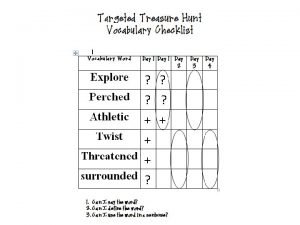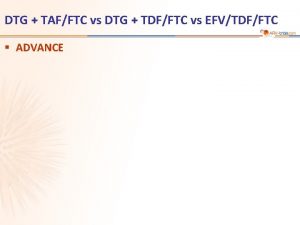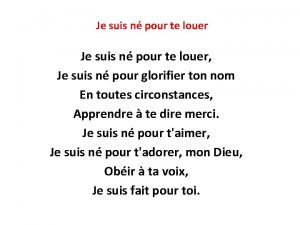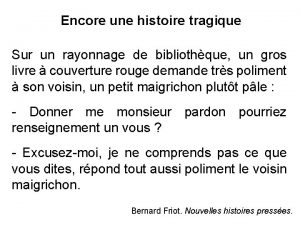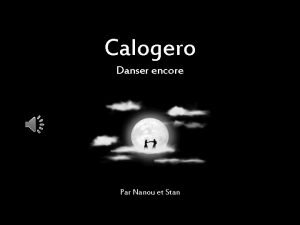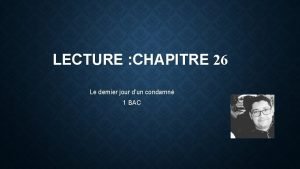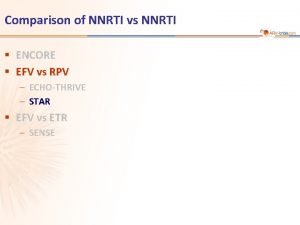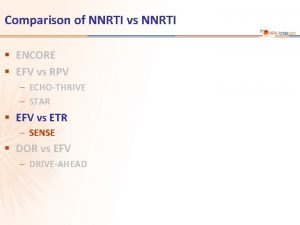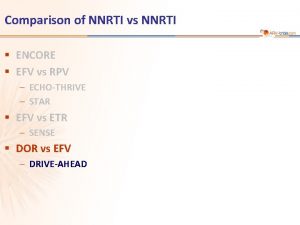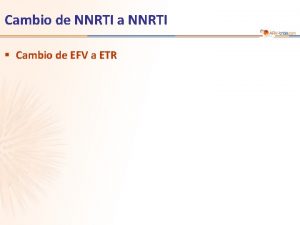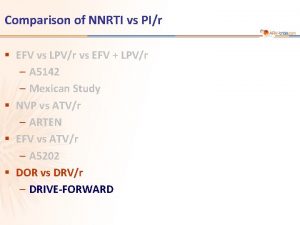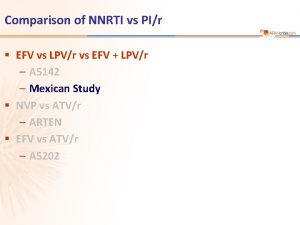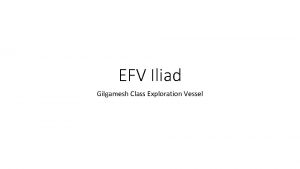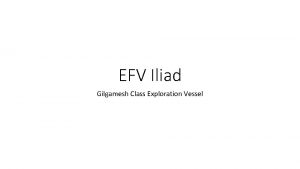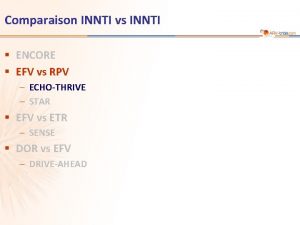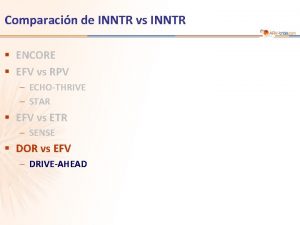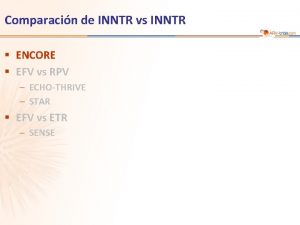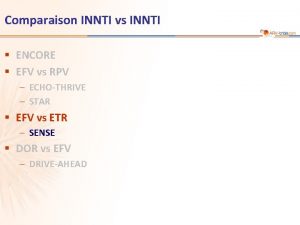Comparison of NNRTI vs NNRTI ENCORE EFV vs















- Slides: 15

Comparison of NNRTI vs NNRTI § ENCORE § EFV vs RPV – ECHO-THRIVE – STAR § EFV vs ETR – SENSE § DOR vs EFV – DRIVE-AHEAD

STAR Study: RPV/FTC/TDF vs EFV/FTC/TDF § Design Randomisation* 1: 1 Open-label > 18 years ARV-naïve HIV RNA > 2, 500 c/m. L Any CD 4 cell count e. GFR > 50 m. L/min Sensitivity to EFV, FTC and TDF on genotype No RPV resistance mutations** N = 394 N = 392 W 48 W 96 RPV/FTC/TDF QD STR EFV/FTC/TDF QD STR Concomitant use of proton pump inhibitors was not allowed * Randomisation was stratified by HIV RNA (< or > 100, 000 c/m. L) ** K 101 E/P, E 138 A/G/K/Q/R, Y 181 C/I/V, H 221 Y § Objective – Non inferiority of RPV/FTC/TDF at W 48: % HIV RNA < 50 c/m. L by intention to treat, snapshot analysis (1 -sided significance level of 2. 5%, lower margin of the 97. 5% CI for the difference = -12%, 95% power) STAR Cohen C. AIDS 2014; 28: 989 -97

STAR Study: RPV/FTC/TDF vs EFV/FTC/TDF Baseline characteristics and patient disposition RPV/FTC/TDF N = 394 EFV/FTC/TDF N = 392 Median age, years 37 35 Female 7% 7% HIV RNA (log 10 c/m. L), median 4. 8 HIV RNA > 100, 000 c/m. L 34% 36% CD 4 cell count (/mm 3), mean 396 385 Discontinuation by W 48 (N) 54 (13. 7%) 72 (18. 4%) For lack of efficacy 12 3 For adverse event 10 34 Lost to follow-up 15 10 Non compliance 6 4 Withdrew consent 5 13 Protocol violation 1 1 Pregnancy 2 0 Investigator’s decision 3 3 Death 0 1 STAR Cohen C. AIDS 2014; 28: 989 -97

STAR Study: RPV/FTC/TDF vs EFV/FTC/TDF Response to treatment (HIV RNA < 50 c/m. L) at week 48 RPV/FTC/TDF % 100 EFV/FTC/TDF Primary analysis 85. 8 88. 8 81. 6 79. 9 81. 7 81. 6 85. 3 79. 6 75 50 25 0 ITT, snapshot Adjusted difference (95% CI) = 4. 1% (-1. 1 ; 9. 2) ITT snapshot, by baseline HIV-1 RNA > 100, 000 c/m. L Difference (95% CI) = -1. 8% (-11. 1 ; 7. 5) < 100, 000 c/m. L Difference (95% CI) = 7. 2% (1. 1 ; 13. 4) ITT, TLOVR Adjusted difference (95% CI) = 5. 9% (0. 6 ; 11. 2) Median CD 4/mm 3 increase at W 48: + 200 RPV/FTC/TDF vs + 191 EFV/FTC/TDF STAR Cohen C. AIDS 2014; 28: 989 -97

STAR Study: RPV/FTC/TDF vs EFV/FTC/TDF Resistance analysis through week 48 Resistance analysis population* Resistance to antiretrovirals In patients with baseline HIV RNA < 100, 000 c/m. L In patients with baseline HIV RNA > 100, 000 c/m. L Any primary NNRTI resistance Y 181 C/I E 138 K/Q K 101 E K 103 N Y 188 L G 190 E/Q Any primary NRTI resistance M 184 V/I K 65 R/N RPV/FTC/TDF EFV/FTC/TDF 20 (5%) 17 (4. 3%) 1. 9% 9. 0% 16 8 6 5 16 15 3 7 (2%) 3 (0. 8%) 0. 8% 0. 7% 3 1 1 1 0 * HIV RNA > 400 c/m. L and suboptimal virologic response (confirmed < 1 log 10 c/m. L decrease in HIV RNA at W 8) virologic rebound (2 consecutive visits with HIV RNA > 50 c/m. L after achieving < 50 c/m. L, 2 consecutive visits with > 1 log 10 c/m. L increase in HIV RNA from the nadir) or HIV RNA > 400 c/m. L at W 48 or last visit STAR Cohen C. AIDS 2014; 28: 989 -97

STAR Study: RPV/FTC/TDF vs EFV/FTC/TDF § Safety through week 48 Grade 3 -4 treatment-emergent adverse events Related to study drug RPV/FTC/TDF EFV/FTC/TDF 7. 4% 1. 8% 13. 8% 4. 8% § Treatment-emergent adverse events of specific interest in > 5% in either arm Nervous system events Dizziness Insomnia Somnolence Headache Psychiatric events Abnormal dreams Depression Anxiety Rash events Folliculitis Rash STAR RPV/FTC/TDF EFV/FTC/TDF 29. 7% 6. 6% 9. 6% 2. 5% 12. 4% 15. 7% 5. 8% 6. 6% 5. 1% 17. 3% 5. 3% 6. 1% 50. 5% 22. 2% 14. 0% 13. 5% 37. 5% 24. 5% 8. 9% 8. 4% 21. 2% 1. 0% 12. 0% Cohen C. AIDS 2014; 28: 989 -97

STAR Study: RPV/FTC/TDF vs EFV/FTC/TDF Mean changes in fasting lipids (mg/d. L) at week 48 RPV/FTC/TDF TC 25 LDL EFV/FTC/TDF TG 22 p < 0. 001 for all between treatment groups using ANOVA 20 14 15 8 10 5 HDL 1 8 2 1 0 -5 -10 Mean baseline values (mg/d. L) -8 164 163 104 103 121 129 44 44 Change in total cholesterol/HDL-cholesterol at week 48 was -0. 2 in both arms STAR Cohen C. AIDS 2014; 28: 989 -97

STAR Study: RPV/FTC/TDF vs EFV/FTC/TDF § Conclusion at week 48 – In treatment-naive HIV-infected patients, RPV/FTC/TDF demonstrated non inferior efficacy and improved tolerability compared with EFV/FTC/TDF, at week 48 • RPV/FTC/TDF was statistically significant superiority in efficacy for patients with baseline HIV-1 RNA ≤ 100, 000 c/m. L • Virologic efficacy was similar for patients with baseline HIV-1 RNA > 100, 000 c/m. L – More discontinuations due to adverse events in the EFV/FTC/TDF arm – Significantly lower rates of nervous system and psychiatric adverse events in the RPV/FTC/TDF arm than in the EFV/FTC/TDF arm • Differences primarily due to dizziness and abnormal dreams – Virologic failures rates were similar between the 2 treatment arms • A greater proportion of patients in the RPV/FTC/TDF arm developed primary emergent NRTI or NNRTI resistance mutations at virologic failure STAR Cohen C. AIDS 2014; 28: 989 -97

STAR Study: RPV/FTC/TDF vs EFV/FTC/TDF Virologic outcomes at W 96, snapshot analysis Virologic success (HIV-1 RNA < 50 c/m. L) Difference (95% CI) Virologic failure EFV/FTC/TDF N = 392 77. 9% 72. 4% 5. 5 (- 0. 6 to 11. 5) ; p = 0. 076 9. 4% 5. 9% HIV-1 RNA ≥ 50 c/m. L 1. 5% Treatment discontinuation due to lack of efficacy 4. 1% 1. 0% Treatment discontinuations due to other reasons and last HIV-1 RNA ≥ 50 c/m. L 3. 8% 3. 3% 12. 7% 21. 7% Treatment discontinuation due to adverse event or death 3. 0% 10. 7% Treatment discontinuations due to other reasons and last HIV-1 RNA < 50 c/m. L 7. 9% 9. 4% Missing data while receiving study drug 1. 8% 1. 5% No data in the study window STAR RPV/FTC/TDF N = 394 Van Lunzen J. AIDS 2016; 30: 251 -9

STAR Study: RPV/FTC/TDF vs EFV/FTC/TDF Response to treatment (HIV RNA < 50 c/m. L) at week 96 % 100 RPV/FTC/TDF at W 48 EFV/FTC/TDF at W 48 RPV/FTC/TDF at W 96 EFV/FTC/TDF at W 96 Favors EFV/FTC/TDF 89 82 80 80 79 82 71 76 Favors RPV/FTC/TDF 75 HIV RNA at baseline 60 < 100, 000 c/m. L W 48 40 W 96 1. 1 7. 2 0. 2 7. 6 W 48 0 W 96 231/ 204/ 205/ 178/ 260 250 107/ 116/ 102/ 106/ 134 142 < 100, 000 c/m. L > 100, 000 c/m. L -11. 1 -1. 8 7. 5 1. 5 -8. 7 -12% 15. 1 p = 0. 046 > 100, 000 c/m. L 20 13. 4 0 11. 6 p = 0. 78 12% Baseline HIV RNA STAR Van Lunzen J. AIDS 2016; 30: 251 -9

STAR Study: RPV/FTC/TDF vs EFV/FTC/TDF Response to treatment (HIV RNA < 50 c/m. L) at week 96 % 100 RPV/FTC/TDF 80. 6 80 60 EFV/FTC/TDF 68. 6 Favors EFV/FTC/TDF 73 Favors RPV/FTC/TDF CD 4 at baseline 60. 4 < 200/mm 3 - 26. 7 40 -8. 0 10. 7 1. 3 7. 7 > 200/mm 3 p = 0. 40 14. 0 p = 0. 018 20 0 -20% 53 51 < 200/mm 3 341 0 20% 341 > 200/mm 3 Baseline CD 4+ cell count STAR Van Lunzen J. AIDS 2016; 30: 251 -9

STAR Study: RPV/FTC/TDF vs EFV/FTC/TDF Resistance analysis at week 96 RPV/FTC/TDF (N = 394) EFV/FTC/TDF (N = 392) Baseline-W 48 -W 96 Subjects in the Resistance Analysis Population 20 (5%) +4 (1%) 7 (1. 8%) +2 (0. 5%) Subjects with Resistance Data 20 (5%) +4 (1%) 7 (1. 8%) +2 (0. 5%) Subjects with Resistance to ARVs 17 (4%) +4 (1%) 3 (0. 8%) +1 (0. 3%) Any primary NNRTI-R Key NNRTI-R 16 (4%) E 138 K/Q (N = 6) Y 181 C/I (N = 8) K 101 E (N = 5) V 90 I (N = 6) +4 (1%) +4 +0 +0 +2 3 (1%) K 103 N (N = 1) Y 188 L (N = 1) G 190 E/Q (N = 1) M 230 L (N = 0) +1 (0. 3%) +0 +0 +0 +1 Any primary NRTI-R Key NRTI-R 16 (4%) M 184 V/I (N = 15) K 65 R/N (N = 3) +4 (1%) +4 +0 1 (0. 3%) M 1841 (N = 1) +1 (0. 3%) +1 5/260 (2%) 12/134 (9%) +4 (1%) +0 2/250 (1%) 1/142 (0. 7%) +1 (0. 4%) +0 With baseline HIV RNA < 100, 000 c/m. L > 100, 000 c/m. L STAR Porter DP. HIV Clin Trials 2015; 16: 30 -8 ; Van Lunzen J. AIDS 2016; 30: 251 -9

STAR Study: RPV/FTC/TDF vs EFV/FTC/TDF Most frequently reported treatment-emergent adverse events leading to permanent study drug discontinuation RPV/FTC/TDF (N = 394) EFV/FTC/TDF (N = 392) W 1 W 4 W 5 W 48 W 96 Total Psychiatric disorder 0 1 (0. 3%) 5 11 8 24 (6. 1%) Nervous system disorder 0 2 1 3 (0. 8%) 5 2 1 8 (2. 0%) Skin and subcutaneous tissue disorder (e. g. rash) 0 0 7 (1. 8%) Clinical laboratory investigation 0 2 2 4 (1. 0%) 0 2 (0. 5%) General disorder (e. g. fatigue) 0 0 3 1 1 5 (1. 3%) Gastrointestinal disorder 0 1 (0. 3%) 1 2 0 3 (0. 8%) Grade 3– 4 treatment-emergent adverse event deemed related to study drug : 2. 3% RPV vs 5. 6% EFV Median changes from baseline to W 96 in creatinine clearance : - 5. 2 m. L/min in the RPV group and + 4. 3 m. L/min in the EFV group 3 discontinuations for renal events : 1 in the RPV group and 2 in the EFV group STAR Van Lunzen J. AIDS 2016; 30: 251 -9

STAR Study: RPV/FTC/TDF vs EFV/FTC/TDF § HIV Symptom Index Questionnaire at W 96 – RPV/FTC/TDF: significant reduction in occurrence of 18/20 symptoms vs baseline (p < 0. 039) – EFV/FTC/TDF: significant reduction in occurrence of 7/20 symptoms vs baseline (p < 0. 033) – Significant between-group differences in symptom occurrence vs baseline for 8 symptoms, all favoring RPV/FTC/TDF § Overall satisfaction (HIV Treatment Satisfaction Questionnaire) at W 96 – High in both groups § Quality of life (SF-12 V 2) – The between-group difference in the median change from baseline at W 96 for the physical health composite score was not significant – The difference for the mental health composite score was significant, favoring RPV/FTC/TDF (p = 0. 014) STAR Van Lunzen J. AIDS 2016; 30: 251 -9

STAR Study: RPV/FTC/TDF vs EFV/FTC/TDF § Conclusion at W 96 – In treatment-naive, HIV-1 -infected adults, 96 -week RPV/FTC/TDF treatment demonstrated noninferior efficacy and better tolerability than EFV/FTC/TDF • Significant differences in virologic success between subgroups with HIV-1 RNA ≤ 100, 000 c/m. L and > 200 CD 4/mmm 3 could be related to the higher rate of discontinuations due to adverse events in the EFV/FTC/TDF group • The higher virologic failure rates observed for RPV/FTC/TDF with baseline HIV -1 RNA > 500 000 c/m. L and CD 4+ cell count ≤ 200/mm 3 were mainly due to a higher rate of discontinuation due to lack of efficacy in this group (limitation: low number of patients in those categories) – Rates of resistance development through W 96 were low (5. 3% RPV/FTC/TDF ; 1. 0% EFV/FTC/TDF) with infrequent emergent resistance after W 48 • Development of resistance at failure: 88% RPV/FTC/TDF vs 44% EFV/FTC/TDF ; resistance in RPV/FTC/TDF group was more frequent if baseline HIV-1 RNA > 100, 000 c/m. L – Better safety and tolerability profile of RPV/FTC/TDF vs. EFV/FTC/TDF over 96 weeks of treatment (limitation: open-label trial) STAR Van Lunzen J. AIDS 2016; 30: 251 -9
 Encore encore aramark
Encore encore aramark Encantado pink dolphin
Encantado pink dolphin Tdf ftc dtg
Tdf ftc dtg Encore
Encore Je suis venu pour te louer
Je suis venu pour te louer Hier encore j'avais 20 ans
Hier encore j'avais 20 ans Encore mnps
Encore mnps Encore une histoire tragique texte
Encore une histoire tragique texte Hier encore javais 20 ans
Hier encore javais 20 ans Quand le ciel est bleu mon garçon
Quand le ciel est bleu mon garçon Danser encore texte
Danser encore texte Encore technology group
Encore technology group Encore counting module
Encore counting module Le chapitre 26 du dernier jour d'un condamné
Le chapitre 26 du dernier jour d'un condamné Encore db
Encore db Limit comparision test
Limit comparision test

